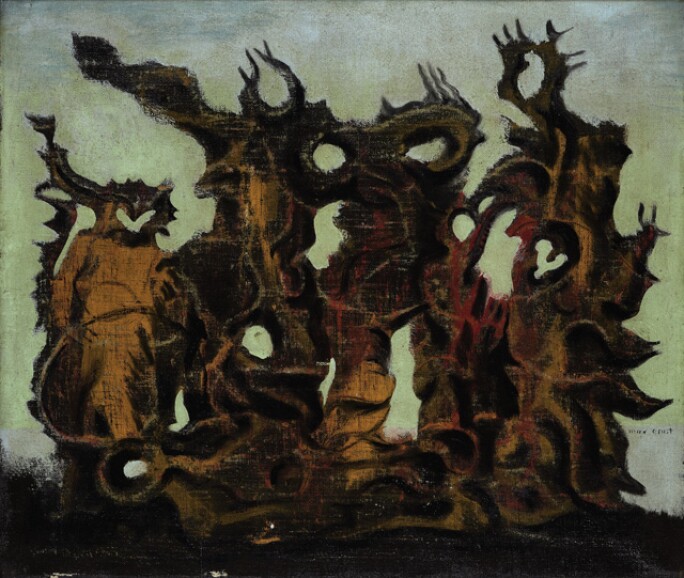F rom 1921, following an intense and fertile Dada period, Max Ernst became one of the foremost influences behind the Surrealist movement. In December 1922, he immortalised the group, canonising the Surrealists in a witty portrait entitled Au rendez-vous des amis. Owing to his invention of the frottage, grattage and coulage techniques, Ernst developed a painting style that prioritised automatism, giving free reign to his imagination and opening the floodgates for interpretation.

MAX ERNST, DANSEUR SOUS LE CIEL (LE NOCTAMBULE), CIRCA 1922. © ADAGP, PARIS AND DACS, LONDON 2017.
On 5th January 1906, the death of Ernst's beloved parrot, Hornebom, coincided with the birth of his little sister Loni. The young Max confused the bird with the new-born child, believing that his parrot had been reincarnated as his sister. Ernst, with his own birdlike profile and perceptive eagle-eye, had no trouble at all later substituting the faces and silhouettes of humans with the heads and bodies of all sorts of birds in his paintings and collages. In May 1921, when he published a thunderous and poetic portrait of his friend Arp — a text which he illustrated with fossils — in the 19th volume of the review Littérature, Ernst did not hesitate to conjure fantastical birdlike images; invoking 'the farting vulture', 'the old man who knew how to fly', and 'the bird as a bird', he stated that 'the swallow from the walls' nested in the slopes of the shoulders of the Dada-Surrealist Arp.

MAX ERNST, JEUNES GENS PIÉTINANT LEUR MÈRE, 1927. © ADAGP, PARIS AND DACS, LONDON 2017.
From July 1925 to March 1928, several paintings with birdlike elements are illustrated in La Révolution surréaliste. These included Deux enfants sont menacés par un rossignol, La Belle jardinière and Monument aux oiseaux by Max Ernst, La Naissance des oiseaux, Oiseau percé de flèches, and Mort d’un oiseau by André Masson and Personnage jetant une pierre à un oiseau by Joan Miró. So it follows that the preface to the March 1926 exhibition Paintings by Man Ray and Objects from the Islands at the Galerie Surréaliste was a simple anthology of birds, with sixteen quotes from the precursors of Surrealism, eight from the Surrealists themselves and three from unlikely authors. The fact remains that Max Ernst was the Surrealist painter of birds par excellence. In 1927, as part of his work for the Éditions Surréalistes, he created Ci-fût une hirondelle, a painted plaster object cast in an edition of twelve. He would furthermore identify throughout his life as Loplop, ‘the most superior of birds,’ who first appeared in a painting of 1928 and then again the following year in his first novel-collage La Femme 100 têtes.

MAX ERNST, LE CHASTE JOSEPH, 1928. © ADAGP, PARIS AND DACS, LONDON 2017.
In the painting Le Chaste Joseph of 1928, the green Mary and black Joseph are depicted as two turtledoves beak-to-beak. The couple stand before a third rather strange bird which is thought to represent the Holy Spirit, traditionally symbolised by a dove. This painting can be read as a somewhat ironic commentary on the conception of the baby Jesus. Le Chaste Joseph evokes another trinity, the trio that was made up for years by Ernst and Paul and Gala Éluard (who later married Salvador Dalí); a ménage-à-trois first revealed in 1925 by the publication of the anonymous book Au défaut du silence, with verses by Éluard and illustrations by Ernst.

MAX ERNST, LES MAINS AUX OISEAUX, 1925. © ADAGP, PARIS AND DACS, LONDON 2017.
The imaginary world of Max Ernst is not at all calm. A murderous spike looms ominously in Les Mains aux oiseaux. Whilst in Jeunes gens piétinant leur mère, it is the title that suggests the extent of the menace. Fascination and dread, procreation and creation, sexuality and sublimation, birds and cages, forests and wonder, automatism and fake mahogany, all compete — in complete accordance with the Surrealist project — for pre-eminence of the mythology in Max Ernst's oeuvre.
MAIN IMAGE: MAX ERNST, DANSEUR SOUS LE CIEL (LE NOCTAMBULE), CIRCA 1922. © ADAGP, PARIS AND DACS, LONDON 2017.


